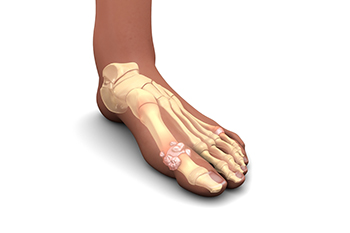Connect With Us
Items filtered by date: June 2024
Relief for Acute Ankle Sprains

Acute ankle sprains are often caused by sudden twists that stretch or tear ligaments surrounding the ankle, causing pain, swelling, and difficulty while walking. Immediate treatment for an acute ankle sprain is important for effective recovery and to prevent long-term complications. Supportive measures include a lace-up brace, an air stirrup brace, or an elastic compression wrap to stabilize the injured ankle and promote faster healing. Early mobilization, as tolerated by pain levels, has been shown to aid in quicker recovery and reduce the risk of chronic ankle instability. Pain relief medications can help to manage inflammation and discomfort. Athletes and those prone to recurrent sprains may wish to consider using ankle supports during sports to prevent future injuries. If you have recently sprained your ankle or are experiencing persistent discomfort, it is suggested that you schedule an appointment with a podiatrist for a personalized treatment plan to ensure proper healing, and to minimize the chance of future ankle problems.
Ankle sprains are common but need immediate attention. If you need your feet checked, contact Ali Davis, DPM from The Foot Clinic. Our doctor can provide the care you need to keep you pain-free and on your feet.
How Does an Ankle Sprain Occur?
Ankle sprains take place when the ligaments in your ankle are torn or stretched beyond their limits. There are multiple ways that the ankle can become injured, including twisting or rolling over onto your ankle, putting undue stress on it, or causing trauma to the ankle itself.
What Are the Symptoms?
- Mild to moderate bruising
- Limited mobility
- Swelling
- Discoloration of the skin (depending on severity)
Preventing a Sprain
- Wearing appropriate shoes for the occasion
- Stretching before exercises and sports
- Knowing your limits
Treatment of a Sprain
Treatment of a sprain depends on the severity. Many times, people are told to rest and remain off their feet completely, while others are given an air cast. If the sprain is very severe, surgery may be required.
If you have suffered an ankle sprain previously, you may want to consider additional support such as a brace and regular exercises to strengthen the ankle.
If you have any questions please feel free to contact our office located in Overland Park, KS . We offer the newest diagnostic and treatment technologies for all your foot and ankle needs.
What Does Tarsal Tunnel Syndrome Feel Like?
 Tarsal tunnel syndrome is caused by compression of the posterior tibial nerve as it passes through the tarsal tunnel, which is a narrow space on the inside of the ankle. This nerve entrapment can result overuse, injury, inflammation, or structural abnormalities, such as flat feet or varicose veins. Symptoms of tarsal tunnel syndrome include tingling, burning, or shooting pain in the foot and ankle, numbness, and a feeling of electric shocks radiating into the sole. These symptoms often worsen with prolonged standing or walking. Diagnosis involves a physical examination, focusing on the areas of pain and nerve compression, in addition to imaging studies like MRI scans or ultrasounds to identify underlying causes. Nerve conduction studies may also be used to assess the function of the posterior tibial nerve. Relief options include rest, anti-inflammatory medications, and exercises to alleviate symptoms. Orthotic devices can help reduce pressure on the nerve, and in severe cases, surgical intervention may be necessary. Complications from untreated tarsal tunnel syndrome can lead to chronic pain and permanent nerve damage. If you have pain in this part of your foot, it is suggested that you schedule an appointment with a podiatrist for a precise diagnosis and individualized treatment plan.
Tarsal tunnel syndrome is caused by compression of the posterior tibial nerve as it passes through the tarsal tunnel, which is a narrow space on the inside of the ankle. This nerve entrapment can result overuse, injury, inflammation, or structural abnormalities, such as flat feet or varicose veins. Symptoms of tarsal tunnel syndrome include tingling, burning, or shooting pain in the foot and ankle, numbness, and a feeling of electric shocks radiating into the sole. These symptoms often worsen with prolonged standing or walking. Diagnosis involves a physical examination, focusing on the areas of pain and nerve compression, in addition to imaging studies like MRI scans or ultrasounds to identify underlying causes. Nerve conduction studies may also be used to assess the function of the posterior tibial nerve. Relief options include rest, anti-inflammatory medications, and exercises to alleviate symptoms. Orthotic devices can help reduce pressure on the nerve, and in severe cases, surgical intervention may be necessary. Complications from untreated tarsal tunnel syndrome can lead to chronic pain and permanent nerve damage. If you have pain in this part of your foot, it is suggested that you schedule an appointment with a podiatrist for a precise diagnosis and individualized treatment plan.
Tarsal tunnel syndrome can be very uncomfortable to live with. If you are experiencing tarsal tunnel syndrome, contact Ali Davis, DPM of The Foot Clinic. Our doctor can provide the care you need to keep you pain-free and on your feet.
Tarsal Tunnel Syndrome
Tarsal tunnel syndrome, which can also be called tibial nerve dysfunction, is an uncommon condition of misfiring peripheral nerves in the foot. The tibial nerve is the peripheral nerve in the leg responsible for sensation and movement of the foot and calf muscles. In tarsal tunnel syndrome, the tibial nerve is damaged, causing problems with movement and feeling in the foot of the affected leg.
Common Cause of Tarsal Tunnel Syndrome
- Involves pressure or an injury, direct pressure on the tibial nerve for an extended period of time, sometimes caused by other body structures close by or near the knee.
- Diseases that damage nerves, including diabetes, may cause tarsal tunnel syndrome.
- At times, tarsal tunnel syndrome can appear without an obvious cause in some cases.
The Effects of Tarsal Tunnel Syndrome
- Different sensations, an afflicted person may experience pain, tingling, burning or other unusual sensations in the foot of the affected leg.
- The foot muscles, toes and ankle become weaker, and curling your toes or flexing your foot can become difficult.
- If condition worsens, infections and ulcers may develop on the foot that is experiencing the syndrome.
A physical exam of the leg can help identify the presence of tarsal tunnel syndrome. Medical tests, such as a nerve biopsy, are also used to diagnose the condition. Patients may receive physical therapy and prescriptive medication. In extreme cases, some may require surgery.
If you have any questions please feel free to contact our office located in Overland Park, KS . We offer the newest diagnostic and treatment technologies for all your foot and ankle needs.
Idiopathic Toe Walking in Children

Idiopathic toe walking is a phenomenon where children habitually walk on their toes without any underlying medical condition or known cause. While toe walking is common in toddlers who are learning to walk, persistent toe walking beyond the age of three without any identifiable cause can be a cause for concern. Children with idiopathic toe walking typically walk on their toes with their heels off the ground during most or all of their walking activities. This behavior can affect their balance, coordination, and overall motor development. While the exact cause of idiopathic toe walking remains unclear, it is believed to involve a combination of factors including tightness in the calf muscles, sensory processing issues, or developmental delays. Early intervention is vital in addressing idiopathic toe walking and preventing potential complications such as muscle stiffness or contractions. Treatment may involve specific stretches that can strengthen the calf muscles, orthotic devices to encourage heel contact, and monitoring to track developmental progress and address any underlying issues. If your child has this condition, it is strongly suggested that you seek the advice of a podiatrist who can guide you toward appropriate treatment measures.
The health of a child’s feet is vital to their overall well-being. If you have any questions regarding foot health, contact Ali Davis, DPM of The Foot Clinic. Our doctor can provide the care you need to keep you pain-free and on your feet.
Tips for Keeping Children's Feet Healthy
- Make sure their shoes fit properly
- Look for any signs of in-toeing or out-toeing
- Check to see if they have Clubfoot (condition that affects your child’s foot and ankle, twisting the heel and toes inward) which is one of the most common nonmajor birth defects.
- Lightly cover your baby’s feet (Tight covers may keep your baby from moving their feet freely, and could prevent normal development)
- Allow your toddler to go shoeless (Shoes can be restricting for a young child’s foot)
- Cut toenails straight across to avoid ingrown toenails
- Keep your child’s foot clean and dry
- Cover cuts and scrapes. Wash any scratches with soap and water and cover them with a bandage until they’ve healed.
If you have any questions, please feel free to contact our office located in Overland Park, KS . We offer the newest diagnostic and treatment technologies for all your foot care needs.
Symptoms and Risk Factors of Gout

Gout is a type of arthritis notorious for its sudden and excruciating pain. Gout typically targets one joint at a time, and commonly strikes in the big toe joint. Flares, which are periods of intense symptoms, alternate with remission phases. The primary culprit behind gout is an excess of uric acid in the body, which forms crystals that accumulate in joints, fluids, and tissues, sparking inflammation. While gout has no cure, it can be effectively managed with medication and certain lifestyle adjustments. Diagnosis by a podiatrist usually occurs during a flare up, involving symptom assessment, physical examination, and lab tests to detect uric acid crystals. Seeking diagnosis and treatment from a podiatrist is important due to gout’s nonspecific symptoms that resemble other inflammatory disorders. Treatment typically involves pain management during flare ups with nonsteroidal anti-inflammatory drugs, NSAIDs, or colchicine. Other preventive measures can include dietary changes to eliminate foods rich in purines and weight management to reduce future attacks and complications. If you are experiencing symptoms like sudden joint pain or swelling, especially in the big toe, it is suggested that you schedule an appointment with a podiatrist.
Gout is a foot condition that requires certain treatment and care. If you are seeking treatment, contact Ali Davis, DPM from The Foot Clinic. Our doctor will treat your foot and ankle needs.
What Is Gout?
Gout is a type of arthritis caused by a buildup of uric acid in the bloodstream. It often develops in the foot, especially the big toe area, although it can manifest in other parts of the body as well. Gout can make walking and standing very painful and is especially common in diabetics and the obese.
People typically get gout because of a poor diet. Genetic predisposition is also a factor. The children of parents who have had gout frequently have a chance of developing it themselves.
Gout can easily be identified by redness and inflammation of the big toe and the surrounding areas of the foot. Other symptoms include extreme fatigue, joint pain, and running high fevers. Sometimes corticosteroid drugs can be prescribed to treat gout, but the best way to combat this disease is to get more exercise and eat a better diet.
If you have any questions please feel free to contact our office located in Overland Park, KS . We offer the newest diagnostic and treatment technologies for all your foot and ankle needs.
Wounds That Don't Heal Need to Be Checked
Blog Archives
- March 2025
- February 2025
- January 2025
- December 2024
- November 2024
- October 2024
- September 2024
- August 2024
- July 2024
- June 2024
- May 2024
- April 2024
- March 2024
- February 2024
- January 2024
- December 2023
- November 2023
- October 2023
- September 2023
- August 2023
- July 2023
- June 2023
- May 2023
- April 2023
- March 2023
- February 2023
- January 2023
- December 2022
- November 2022
- October 2022
- September 2022
- August 2022
- July 2022
- June 2022
- May 2022
- April 2022
- March 2022
- February 2022
- January 2022
- December 2021
- November 2021
- October 2021
- September 2021
- August 2021
- July 2021
- June 2021
- May 2021
- April 2021
- March 2021
- February 2021
- January 2021
- December 2020
- November 2020
- October 2020
- September 2020
- August 2020
- July 2020
- June 2020
- May 2020
- April 2020
- March 2020
- February 2020
- January 2020
- December 2019
- November 2019
- October 2019
- September 2019

